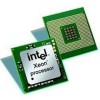Intel X5472 Specification Update - Page 26
Proper Semaphores or Barriers May Expose a Memory Ordering Issue
 |
UPC - 735858201551
View all Intel X5472 manuals
Add to My Manuals
Save this manual to your list of manuals |
Page 26 highlights
Workaround: Write to CR3, CR4 (setting bits PSE, PGE or PAE) or CR0 (setting bits PG or PE) registers before writing to memory early in BIOS code to clear all the global entries from TLB. Status: For the steppings affected, see the Summary Tables of Changes. AX29. Split Locked Stores May not Trigger the Monitoring Hardware Problem: Logical processors normally resume program execution following the MWAIT, when another logical processor performs a write access to a WB cacheable address within the address range used to perform the MONITOR operation. Due to this erratum, a logical processor may not resume execution until the next targeted interrupt event or O/S timer tick following a locked store that spans across cache lines within the monitored address range. Implication: The logical processor that executed the MWAIT instruction may not resume execution until the next targeted interrupt event or O/S timer tick in the case where the monitored address is written by a locked store which is split across cache lines. Workaround: Do not use locked stores that span cache lines in the monitored address range. Status: For the steppings affected, see the Summary Tables of Changes. AX30. Programming the Digital Thermal Sensor (DTS) Threshold May Cause Unexpected Thermal Interrupts Problem: Software can enable DTS thermal interrupts by programming the thermal threshold and setting the respective thermal interrupt enable bit. When programming DTS value, the previous DTS threshold may be crossed. This will generate an unexpected thermal interrupt. Implication: Software may observe an unexpected thermal interrupt occur after reprogramming the thermal threshold. Workaround: In the ACPI/OS implement a workaround by temporarily disabling the DTS threshold interrupt before updating the DTS threshold value. Status: For the steppings affected, see the Summary Tables of Changes. AX31. Writing Shared Unaligned Data that Crosses a Cache Line without Proper Semaphores or Barriers May Expose a Memory Ordering Issue Problem: Software which is written so that multiple agents can modify the same shared unaligned memory location at the same time may experience a memory ordering issue if multiple loads access this shared data shortly thereafter. Exposure to this problem requires the use of a data write which spans a cache line boundary. Implication: This erratum may cause loads to be observed out of order. Intel has not observed this erratum with any commercially available software or system. Workaround: Software should ensure at least one of the following is true when modifying shared data by multiple agents: • The shared data is aligned • Proper semaphores or barriers are used in order to prevent concurrent data accesses. Status: For the steppings affected, see the Summary Tables of Changes Intel® Xeon® Processor 5400 Series 26 Specification Update















